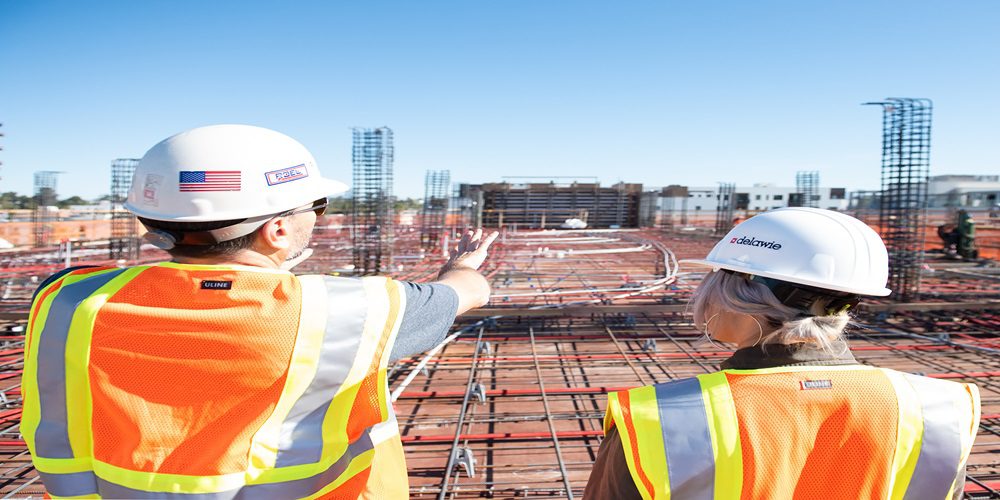Welcome to the future of construction! Strap on your hard hat and get ready to dive into a world where buildings grow before our eyes, drones orchestrate symphonies of efficiency, and robots wield hammers with precision. In this blog post, we’ll be exploring the cutting-edge trends and mind-blowing innovations that are revolutionizing the construction tech industry for 2024 and beyond. It’s time to break ground on tomorrow’s world today – so let’s grab our blueprints, embrace the digital tools at hand, and build a future that surpasses even our wildest dreams!
Introduction: Explaining the significance of the construction tech industry and its potential for growth in 2024.
The construction tech industry is a rapidly growing sector that has been gaining more and more attention in recent years. This is due to the increasing demand for efficient and innovative solutions in the construction industry, as well as the advancements in technology that have made these solutions possible.
In 2024, the global construction tech industry is projected to reach a market value of $414 billion, with a compound annual growth rate (CAGR) of 11.8% from 2019 to 2024. This reflects the immense potential for growth and opportunities within this industry.
But what exactly is construction tech? Simply put, it refers to any technology that improves processes or adds value to the construction industry. This can include anything from software used for project management and design, to advanced machinery and equipment used for construction purposes.
One significant factor driving the growth of this industry is the need for increased efficiency and productivity in construction projects. With urbanization on the rise and population growing globally, there is a high demand for new infrastructure such as residential buildings, commercial spaces, roads, bridges, etc.
Consequently, there is immense pressure on the construction industry to deliver high-quality projects within tight deadlines while also ensuring cost-effectiveness. This demand has led to an increasing adoption of technologies within the sector that can help streamline operations and improve overall efficiency.
Impacts of Technology on Construction: Discussing how technology is revolutionizing various aspects of the construction process, from design to project management.
The construction industry has long been known for its traditional methods and practices, with little room for technological advancements. However, in recent years, there has been a significant shift towards incorporating technology into every aspect of the construction process. From design to project management, technology is revolutionizing the way buildings are constructed, leading to faster completion times, improved efficiency, and cost savings.
1.1 Design:
In the past, architectural design was done mostly on paper and involved laborious manual calculations. Today, thanks to advanced computer-aided design (CAD) software programs like AutoCAD and Revit, architects can draft designs more accurately and efficiently. These software programs also allow for 3D modeling, giving clients a better understanding of what their building will look like before it’s even built.
Moreover, virtual reality (VR) technology is increasingly being used in the design process to create immersive experiences. This allows clients and builders to visualize every detail of the project before construction begins, making changes easier to implement during the early stages when they are most cost-effective.
1.2 Building Information Modeling (BIM):
One of the most significant technological innovations in the construction industry is Building Information Modeling (BIM). BIM is a digital representation of a building that contains all its components and data throughout its lifecycle – from design to demolition.
Through BIM software systems like Autodesk BIM 360 or Trimble Connect, all stakeholders in a construction project can work collaboratively on one platform in real-time. This eliminates communication barriers and reduces design conflicts and errors, resulting in a more efficient construction process.
1.3 Prefabrication and Modular Construction:
Technological advancements have also transformed the way buildings are constructed on-site. Prefabrication and modular construction techniques are increasingly being used to speed up the building process while maintaining quality standards.
Prefabricated elements such as walls, floors, and roofs are built off-site in a controlled environment using advanced machinery. This allows for better precision, faster construction times, and reduced waste. These elements can then be transported to the construction site where they are assembled like building blocks, minimizing on-site work and disruption.
1.4 Drones:
Drones have become an essential tool in the construction industry. They allow for accurate aerial surveys of a construction site, providing valuable data for planning and monitoring progress. They can also capture high-quality images that can be used to create 3D models of a structure or track the progress of a project over time.
Furthermore, drones equipped with thermal cameras can detect heat loss from buildings, identifying areas that need insulation or repair – saving time and money on manual inspections.
1.5 Project Management:
Technology has revolutionized project management in the construction industry. Project management software such as Procore, Plan
Emerging Technologies: Exploring futuristic technologies such as 3D printing, robotics, and virtual reality that have
The construction industry is constantly evolving and improving with the use of new technologies. In recent years, there has been a surge in the development and use of futuristic technologies such as 3D printing, robotics, and virtual reality. These innovations have shown great potential to revolutionize the construction tech industry by increasing efficiency, improving safety, and reducing costs.
Let’s delve deeper into each of these emerging technologies and explore their potential impact on the future of construction.
3D Printing:
Also known as additive manufacturing technology, 3D printing has gained significant attention in the construction industry in recent years. It involves creating three-dimensional objects by adding layers upon layers of material based on a digital model or blueprint. While still in its early stages in terms of adoption within the industry, it has already shown immense potential for optimizing design and construction processes.
One significant advantage of 3D printing is its ability to create complex geometries that are difficult to achieve through traditional construction methods. This opens up possibilities for innovative architectural designs, reduced material waste, and faster project timelines.
Moreover, 3D printing can also be used to create prefabricated components off-site or at remote locations which can then be assembled on site. This method reduces labor costs and increases safety by minimizing human involvement in potentially hazardous tasks.
Robotics:
In recent years, there has been a rise in the use of robots in various industries – including construction. Robots are machines designed to carry out complex and repetitive tasks with precision, speed, and accuracy. In the construction industry, robots can be used for tasks such as bricklaying, welding, and demolition.
One significant advantage of using robots in construction is their ability to work 24/7 without breaks or fatigue. This means that projects can be completed at a faster pace than traditional construction methods. Moreover, robots also reduce the risk of accidents and injuries by performing tasks that are dangerous for humans.
Another exciting application of robotics in construction is the use of drones for surveying, mapping, and inspection purposes. Drones equipped with cameras and sensors can collect data and provide real-time monitoring of construction sites, reducing the need for human intervention.
Virtual Reality:
Virtual reality (VR) technology has been gaining traction in the construction industry as a tool for planning, designing, and training purposes. It allows users to experience a simulated environment through a headset or other devices and interact with digital objects in a three-dimensional space.
Conclusion
As we look towards the future of construction technology and its potential impact on our world, it is clear that innovation and trends will continue to drive the industry forward. From advanced robotics and 3D printing to sustainable building materials and smart cities, the possibilities for creating better, more efficient structures are endless. It is up to us as individuals and organizations to embrace these advancements and work towards building a brighter tomorrow using today’s cutting-edge technologies. So let’s harness the power of innovation, embrace change, and build a better world for ourselves and generations to come.



































